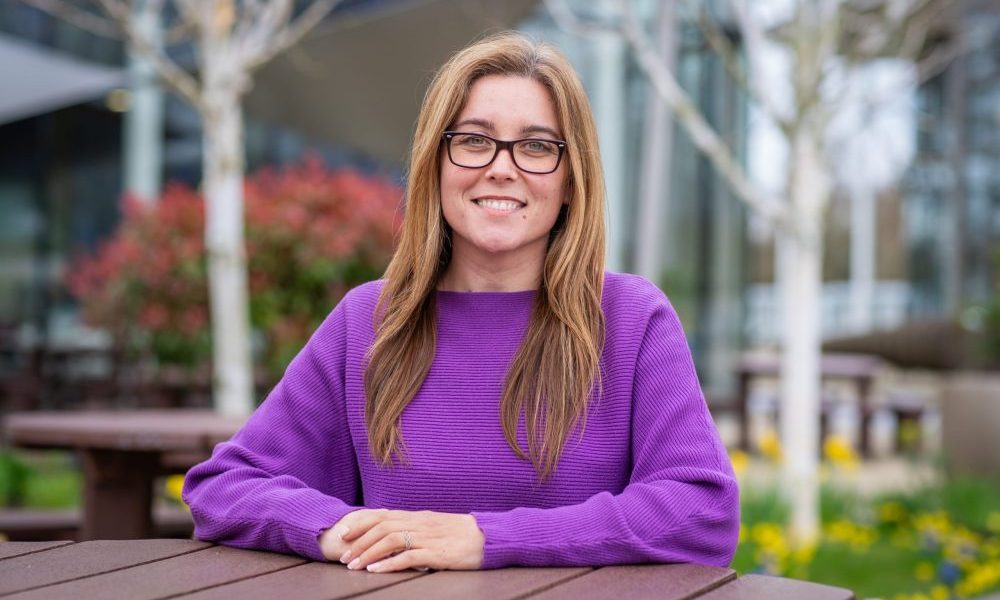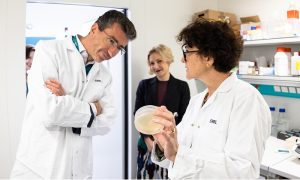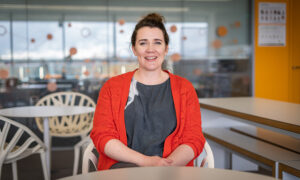
We are EMBL: María Cerezo on balancing two roles and one of EMBL’s proudest achievements
María Cerezo talks about her role as Scientific Curator, how she combines it with her position as co-chair of the Staff Association*, and what she believes has been EMBL's biggest achievement in its first 50 years

Scientific curators play a crucial role in the development of EMBL’s open data resources. In a nutshell, they check the studies that are published each week and select those that meet EMBL’s eligibility criteria for inclusion in its databases. After understanding the study design, they extract all the information in a standardised format. This is then reviewed by another curator and, if everything is correct, the information is made public on the website.
María Cerezo is a scientific curator at EMBL-EBI, a role she combines with her position as co-chair of the Staff Association.* In this interview, María shares more about her work, her responsibilities in the Staff Association, and why she believes that open science is one of EMBL’s proudest achievements in its first 50 years.
Tell us more about your role as a Scientific Curator and what aspects of your job you find most enjoyable and fulfilling.
I had never heard of this role until I applied for it. It is quite specific to databases, where EMBL-EBI is a key player worldwide. I have always been quite detail-oriented, so I suppose that skill matched this role perfectly. You need to have a scientific background to understand the study design. At the same time, you must be a team player, because you review others’ curation and your work is reviewed by your colleagues.
What I like the most is definitely the interaction with our users, the engagement with the scientific community, and feeling that you are helping other scientists in their research, by saving them a lot of time and effort. Another important aspect is knowing we are producing quality data which will be used for more advances in research, drug development, and personalised medicine.
In addition to your role as a scientific curator, you’re actively involved in the Staff Association as a co-chair*. How do those roles intersect or support each other and could you share what motivated you to pursue this additional responsibility?
I joined the Staff Association six years ago to help and speak up for colleagues who do not feel comfortable raising their voices but would like to see changes. I wanted to contribute to making those changes to improve our time at EMBL. My motivation to run for senior roles was to work on the strategy of the committee to reach our goals, and to represent the committee in meetings with management, where we negotiate how and when to make changes to improve working conditions.
Both my roles – Scientific Curator and Staff Association Co-Chair – require organisation and collaboration for effective results. Thanks to my time at the Staff Association, I have gained experience in organising and sharing information. Thanks to my scientific background, I learned how to share my work in conferences, which helps me with all the meetings and presentations I do regularly in both roles.
What are the key responsibilities and functions of a Staff Association representative?
For me, the main point is to help my colleagues in case they need it. Everything shared with a representative is confidential unless it is explicitly agreed that the information will be shared with others for intervention purposes.
We are informed of the rules and regulations related to providing correct information, and about specific topics relevant to staff, which we discuss with EMBL’s management teams. We have guidelines for the specific duties and responsibilities that are set out on our website and we run training for Staff Association representatives every year to help us do it properly.
We ask for feedback with surveys and organise events for staff to interact with us. We need to know what is happening in case something should change or can be improved. As I always say, “help us to help you!”
What is a typical day like for you?
I have to split my time between both roles. Due to my senior role and the workload in the Staff Association Committee, my tasks in the Catalog are reduced. I review the literature to be included in the database, check the latest updates in the community for X (I still prefer to call it Twitter!), and if I have time, I provide support in the curation process or solving other’s doubts. For the Committee, I check the calendar for the meetings of the day and review the topics I would like to discuss. If the meeting is with management, I review the minutes of the internal discussions with other representatives; if the meeting is with the Committee, I review documents for information and discussion or prepare presentations with summaries of the topics. If there are no meetings, I usually read Council documents to learn how certain decisions were made at EMBL years ago, internal documents to learn how previous representatives were discussing the same topics in the past, or Staff Association documents from other organisations to know if they are doing things differently and we can try to change in that direction.
What is your proudest achievement from your time at EMBL?
I feel proud every time someone says “Thank you for your work.”
After having been around for a while, I am lucky to have participated in many reviews and discussions which had positive outcomes for EMBL staff.
I always repeat that my biggest achievement as Staff Association representative would be if my colleagues only needed to approach us for information and tickets for events, while knowing that we were offering much more than that. That would mean we improved their working conditions and they did not face difficulties during their time at EMBL.
What do you think has been EMBL’s greatest impact so far? What do you think EMBL should be proud of at this point in its organisational history?
I cannot mention just one! In 50 years, people at EMBL have done awesome science, not only doing experiments but also supporting researchers in focusing on theories, while doing administrative work, helping with grants, developing new technologies, creating and maintaining new infrastructures for data collection and sharing, developing new policies to navigate between national and international legislations, teaching new scientists, and more. There are many things EMBL should be proud of, but if I have to highlight one, that would be its commitment to open science. As a pan-European institution, we share science produced at EMBL but also at other places through our resources.
If there was a motto on your desk, what might it say?
“What we do together will make a difference.”
What is one thing about you that most people don’t know?
There are lots! As a nerdy geneticist, I know I have both variants for misophonia (feeling rage at the sound of other people chewing) and also ancestral variants for the perception of some smells. But I still do not know which variants made me left-handed or gave me my light green eyes. Something not linked to genetics – I share my birthday with one of my brothers. No, we are not twins, he arrived seven years later!
*Maria is no longer a Staff Association representative. Please see the current members of the Staff Association at the different EMBL sites on the Staff Association website under Info and News.


